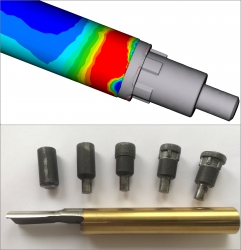QForm Cold Forming
 Simulation of die stress-strain state in QForm for cold forming processAs opposed to hot forging, cold forming technologies yield a precise high-quality shape that reduces or eliminates the need for machining of the forged part. These are the main reasons to use cold forming technologies in technologies such as orbital forming, cold forging and cold upsetting of metalware (nuts, screws) and cold thread rolling.
Simulation of die stress-strain state in QForm for cold forming processAs opposed to hot forging, cold forming technologies yield a precise high-quality shape that reduces or eliminates the need for machining of the forged part. These are the main reasons to use cold forming technologies in technologies such as orbital forming, cold forging and cold upsetting of metalware (nuts, screws) and cold thread rolling.
Special materials are used for cold forging that allow cold deformation without fracture.
To simulate cold forming accurately it is necessary to use rheological models of materials which were tested at cold forging temperatures (in general 20 – 400 degrees Celsius).
To evaluate fracture defects in cold forming simulations it is possible to implement criteria such as Cockcroft-Latham, V.L. Kolmogorov, Wierzbicki, Del, Johnson & Cook, McClintock, Rice and Tracy, V.A. Ogorodnikov, Yu.G. Kalpin in QForm.
It is very important to take elastic deformation of the tool into account in cold forging processes because has a very big influence on the shape of the forged part.
T.S.Yamunai Thuraivan, Sundram Fasteners Limited. E-mail: [email protected]
QForm takes elastic tool deformations into account with our specially developed models including:
- coupled mechanical task - when the workpiece is deformed as a plastic body (elastic-plastic) and the tool as an elastic-plastic
- thermo-elastic-plastic model of cooling to consider local thermal stresses
Advantages
- Measurement of the sizes of the forging to evaluate quality of forming
- Defects identification in forged part
- Prediction of deformation load and verification of coldformer or press capacity
- Tool life estimation and prediction of weak spots in the die and punch
- Tool wear prediction and optimization
 Hydroforming simulation in QForm
Hydroforming simulation in QForm High values of effective stress in the die at the last forging step. QForm simulation results and the broken die
High values of effective stress in the die at the last forging step. QForm simulation results and the broken die
Special QForm features that help simulate cold forming
- Use of Cockcroft-Latham fracture criterion to predict fracture defects
- Coupled mechanical and thermal tasks which help evaluate the influence of die deflection on the final shape of the forging
- Use of prestressed die assemblies
- Implementation of user subroutines written in LUA programming language
- Prediction of forging quality by evaluation of plastic strain field and special fields which can be calculated from user subroutines
- Applying different lubricants on different die surfaces
- Advanced capabilities to control finite element mesh that play a significant role to achieve good quality results in simulation of sheet-bulk metal forming processes




